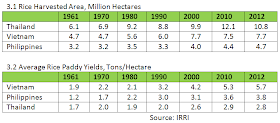-----------
(2) Rice prices. PNoy said (SONA 2014),
“…some greedy rice hoarders are stockpiling their supplies in order to
sell them when prices eventually rise…. Our immediate solution: import more
rice, supply it to the markets, reduce the prices and keep them at a reasonable
level, and ultimately drive those who took advantage of the Filipino people
into financial ruin.”
Last November, we imported 500,000 metric tons… all of this had arrived
by March of this year. This February…
additional 800,000 metric tons,... This July we approved the immediate
importation of 500,000 metric tons of rice through open bidding…. Standby authority to import an additional
500,000 metric tons…”
The anomaly actually here is the Philippine government's
continuing rice protectionism policy and monopolization or heavy regulation of
rice imports, that largely explains for high rice prices.
Rice protectionism via (1) National Food Authority (NFA)
rice importation monopoly and (2) maintaining quantitative restrictions (QRs)
of our rice imports, and (3) forcing rice "self-sufficiency" policy,
are wrong policies that contribute to
expensive rice. They are anti-liberal policies that the Liberal Party should in
fact discard while PNoy Aquino is still in power.
Below is a picture of how big our neighbors Vietnam and
Thailand are as rice exporters. They simply have huge production relative to
their consumption.
Table 2. Rice
Production, Trade and Consumption in East Asia, in ‘000 Metric Tons
Myanmar and Cambodia are fast catching up as major rice
producers and consumers, which is a good thing.
These four countries – Vietnam, Thailand, Myanmar and
Cambodia – plus Laos, are all in Southeast Asia mainland. The rice import-dependent countries –
Indonesia, Malaysia and Philippines – are all archipelagic and are outside the Southeast
Asia mainland. Is this coincidence or not, that there is an explanation for
this?
A paper from Dr. David Dawe of the Food and Agriculture
Organization (UN FAO) and reposted in IRRI magazine, “Rice self-sufficiency: A
question of geography?” says the answer is No. It is not coincidence.
Chart 5. Rice
Production per Capita vs. Share of Crop Area Devoted to Rice, ASEAN
Countries on SE Asia mainland have dominant river deltas
that provide huge water and flat lands, they get big irrigation from Mekong
River (water flowing from China down to Laos, Cambodia, Thailand, Vietnam),
also from Ton le Sap river (mainly in Cambodia). This flat lands plus huge
irrigation are highly suitable for rice
cultivaton.
Rice land in particular, Vietnam has almost 2x while Thailand has
almost 3x that of Philippine rice land area.
Productivity wise, Filipino farmers’ is actually larger
than that of their counterparts in Thailand, although lower than those in Vietnam.
If Vietnam has the same number of typhoons per year as the Philippines, its
productivity would possibly be similar to the Philippines. Vietnam has only about
5 typhoons a year or less, vs. the PH's 19 typhoons a year on average, about
half of which make actual landfall and knock down thousands of hectares of
often harvestable rice, resulting in
high crop losses.
Table 3. Rice Land
and Output, Comparison among the Philippines, Thailand and Vietnam
If we combine those natural factors – being in SE Asia
mainland, have huge and wide flat lands, have huge irrigation water – those in the mainland have high rice
output relative to their consumption and hence, rice prices are lower than those in the Philippines. Why should the Philippine
government insist on expensive rice via trade protectionism?
Chart 6.
Comparative Wholesale Rice Prices, Philippines, Thailand and Vietnam, 2000-2014
A report from PhilRice also noted this,
"According to
the two PhilRice economists, domestic price of rice was up to 75% higher than
average global rice prices in 2000. The gap reduced in 2008, but price
differential widened again to around 30% in 2012 mainly due to higher import
tariffs (of about 50% beyond quantitative restrictions quota) and higher
production costs.' (source: http://oryza.com/.../philrice-calls-rice-competitiveness...)
To bring down rice prices and stabilize rice supply, the
following modest proposals are advanced.
1. Government should liberalize rice trade and
importation, abandon rice protectionism. Remove National Food Authority (NFA)
monopoly in rice imports.
2. End the quantitative restrictions (QRs) and convert it
to low tariff, ultimately leading to zero tariff, especially for rice imports
from our neighbors in the ASEAN.
3. In exchange for rice trade liberalization and removing
NFA import monopoly, its accumulated debt, around P155 billion, may have to be assumed by the national government. This means taxpayers including
those who do not buy NFA rice, will pay for its debt.
4. Certain NFA assets like some warehouses should be
privatized. Proceeds from such privatization should be used entirely to retire
some of its debt and not be used for any old or new food subsidy programs. This
way, NFA debt that will be passed on to the national government and will
be paid by taxpayers will be smaller.
----------See also:
Free Trade 34: ASEAN's Bilateral and Regional FTAs, February 27, 2014
Free Trade 35: EU-FNF Forum on 'FDI Engine for Job Growth', May 15, 2014
Free Trade 36: Taxation, Regulations, Trade and Rule of Law in ASEAN, August 05, 2014
Free Trade 37: Multiple Concerns and Regulations in the ASEAN, September 11, 2014
Agri Econ 14: NO to Further Extension of Agrarian Reform, July 03, 2014





No comments:
Post a Comment